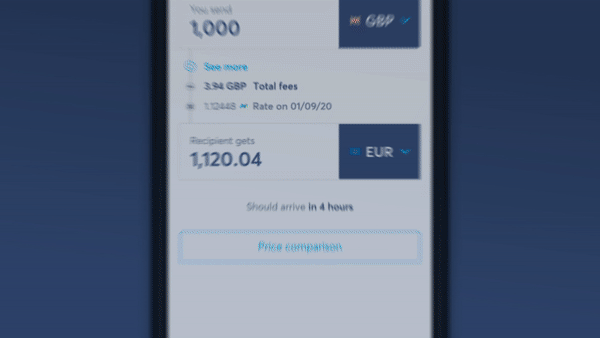Complete Guide to Sending and Receiving International Money Order Online through India Post [2025]
Learn how India Post's international money orders work with France and UAE, plus discover Wise as a modern alternative for global transfers.

There are multiple ways to send money to another bank account, including by wire or bank transfer. Confused about the difference between the two? Read on to learn how and where they differ so you are ready for your next transfer.
| 📝 Table of contents |
|---|
A wire transfer is an electronic way to move money from one bank account to another through the financial system. You can do both domestic wire transfers to another bank, and international wire transfers for bank accounts overseas.
Most banks around the world are members of the Society for Worldwide Interbank Financial Telecommunication, known as the SWIFT network system. By being part of SWIFT, every single bank gets a specific code to be identified by to make transfers easy. So when you want to send an international wire transfer or receive one, having the SWIFT code of the receiving bank is important.
With the SWIFT code, the receiving bank can be located, and then the money can be deposited in the person’s or business’ specific account. It works electronically by providing instructions to the bank within a messaging system.
Wire transfers through the SWIFT system can take 2-5 business days to process, depending on the sender and receiver’s locations. There is almost always a wire transfer fee given by the service provider, whether a bank or third-party service.
Alongside the SWIFT system is the International Bank Account Number or IBAN network. This is used primarily in Europe and is a similar system that helps identify banks. The US does not use IBAN, but if you have an IBAN number for a non-US account it is advised to provide that in the transfer details too.
Services like Wise, Western Union, or Remitly can all complete a wire transfer when sending money globally.¹
A bank transfer can be a form of payment or a transfer to someone’s account that is done through a bank.
Bank transfers are mostly for domestic transactions and allow banks to send money to each other. Rather than instructions with a wire transfer, there is a pull-push action with the money from bank to bank so the money is deposited.
Traditional bank to bank transfers used to be cheap but take more time than wire transfers. But some banks have made it easy and fast to send money to each other within the same country. These banks have allowed for third party companies to help out, or integrated underlying systems that banks can use to facilitate quicker transfers.²
Indian banks have made transactions within the country faster through quick transfers services like UPI and RTGS, NEFT, and IMPS. The BHIM-UPI system allows for instant transfers with the individual mobile number connected to the recipient’s bank account. Indian bank to bank payments like RTGS, NEFT, and IMPS allow for fast transfers as long as you have the bank account information- and not just the mobile number. But there may be caps on how much can be sent.
In the UK, there is a Faster Payments Service (FPS) to make simple bank-to-bank transfers in the country. It allows for real-time payments and can be done through your bank’s online banking or app. Bank transfers in the UK require the recipient’s UK bank’s sort code for transfers. The sort code is a unique code given to every UK bank in the country.³
A few American banks have partnered with Zelle to make bank-to-bank transfers fast and easy with only an email address. Zelle payments can show up in a US domestic account within a few minutes. Also, ACH, or automated clearing house, allows for transfers, and many Americans will be familiar with it for payments of bills and paychecks too.⁴
| 🔖Read more: ACH vs Wire transfers |
|---|
As the name suggests, only banks can provide bank transfers. Some global banks, like Citibank, will allow bank transfers within the different bank accounts you hold with them globally.
While both get your money where it needs to go, there are differences between a wire and a bank transfer. Here is a quick table:⁵
| Wire Transfer | Bank Transfer | |
|---|---|---|
| Mode | Service providers, companies or banks | Banks |
| System | SWIFT/ IBAN | ACH or RTGS, NFT, IMPS (depends on country) |
| Where can transfers go | International & domestic | Domestic |
| Type of transfers | Electronic | Electronic |
| Speed | 1-5 days | 4-5 days |
| Purpose | Personal use, remittances, to support family | Personal use, bill payments |
| Fees | $0-$25 | $0 but can be a fee if sending over the limit |

| 🚀 International transfers are fast, simple, and cheap with the Wise Web/Android/ iOS app |
|---|
Open your free Wise account now 🚀
Wise uses smart tech to help save you money when sending money abroad and keep your transaction safe and secure. With your recipient’s bank details and information, you can send money directly to their local currency account. And on popular routes, the money can be there in under a minute.
You will only get the real exchange rate- the same one you see on Google- when you are sending money overseas with Wise. That means no mark-ups, ever. There is just one small transaction fee, that’s it.
And if you are in one of the currently supported countries, check out the Wise multi-currency account. It is a single account with 65+ currencies that you can hold, send, and receive money globally. The account comes with a linked debit card so you can buy like a local wherever you are in the world.
Sources used for this article:
All sources checked as of 17 March, 2022
*Please see terms of use and product availability for your region or visit Wise fees and pricing for the most up to date pricing and fee information.
This publication is provided for general information purposes and does not constitute legal, tax or other professional advice from Wise Payments Limited or its subsidiaries and its affiliates, and it is not intended as a substitute for obtaining advice from a financial advisor or any other professional.
We make no representations, warranties or guarantees, whether expressed or implied, that the content in the publication is accurate, complete or up to date.

Learn how India Post's international money orders work with France and UAE, plus discover Wise as a modern alternative for global transfers.

Complete guide to understanding the limitations of direct ACH transfers from India to USA, and a review of Wise as an alternative that can help.

Revolut is not yet available in India, but you can join the waitlist. Learn about their plans for India and discover Wise as an alternative for money transfers.

WhatsApp UPI for India: Can you send or receive money international? Discover limits, safety & Wise as a global transfer alternative.

Complete review of Vance Money Transfer services to India in our guide to that covers their features, fees, and supported countries.

विदेश पैसे भेजने के आसान तरीके सीखें। नकद, बैंक ट्रांसफर, और Wise जैसे ऑनलाइन विकल्पों की जानकारी। फीस और एक्सचेंज रेट समझें।